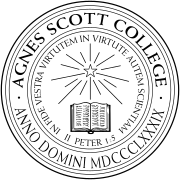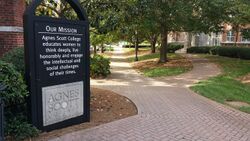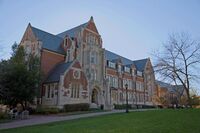Agnes Scott College
Topic: Organization
 From HandWiki - Reading time: 12 min
From HandWiki - Reading time: 12 min
 | |
Former names | Decatur Female Seminary (1889–1890) Agnes Scott Institute (1890–1906) |
|---|---|
| Motto | In Fide Vestra Virtutem In Virtute Autem Scientiam |
Motto in English | Add to your faith virtue and to your virtue knowledge |
| Type | Private women's liberal arts college |
| Established | 1889 |
Religious affiliation | Presbyterian |
Academic affiliations | APCU Annapolis Group Oberlin Group CIC WCC Space-grant |
| Endowment | $247,1 million (2022)[1][2] |
| President | Leocadia I. Zak |
Academic staff | 127[3] |
| Students | 1,124 (Fall 2022)[4] |
| Undergraduates | 950 (Fall 2022)[5] |
| Location | Decatur , Georgia , 30030-3770 , United States |
| Campus | Suburban; total 91 acres (37 ha) Athletic complex 7 acres (2.8 ha) Bradley Observatory and Delafield Planetarium 1.5 acres (0.61 ha) |
| Newspaper | Agnes Scott Profile |
| |u}}rs | Scottie Purple, yellow, gold, grey, black (official colors) Purple & white (athletic colors) |
| Nickname | Scotties |
| Mascot | Scottish Terrier |
| Website | www |
Agnes Scott College is a private women's liberal arts college in Decatur, Georgia. The college enrolls approximately 1,000 undergraduate and graduate students. The college is affiliated with the Presbyterian Church and is considered one of the Seven Sisters of the South.[6] It also offers co-educational graduate programs.
History
The college was founded in 1889 as Decatur Female Seminary by Presbyterian minister Frank Henry Gaines. In 1890, the name was changed to Agnes Scott Institute to honor the mother of the college's primary benefactor, Col. George Washington Scott. The name was changed again to Agnes Scott College in 1906, and remains today a women's college.
Agnes Scott is considered the first higher education institution in the state of Georgia to receive regional accreditation.[7][8] The ninth and current president since July 2018 is Leocadia I. Zak, who previously worked as director of the U.S. Trade and Development Agency (USTDA).
On July 27, 1994, the campus was listed on the National Register of Historic Places as part of the South Candler Street-Agnes Scott College Historic District.[9] The historic district boundaries are East College Ave., South McDonough St., S. Candler St., East Hill St. and East Davis St. It includes the entire campus, as well as historic homes adjacent to the campus. The campus is also designated by the City of Decatur as a historic district.[citation needed]
The Reverend Frank Henry Gaines served as the first President of Agnes Scott, formally known as Decatur Female Seminary School, for 27 years (1896-1923). During his 27-year presidency, he ensured stability and success for the school, including the transition to the collegiate level, accreditation by the Southern Association of Colleges and Schools, acquisition of 20 acres of land and 21 buildings and an increase in assets from $5,000 to $1.5 million.
Campus
Agnes Scott College is located within walking distance of downtown Decatur. A MARTA subway station, located in downtown Decatur, allows students to travel to Atlanta.
Agnes Scott (Main) Hall, named after Agnes Irvine Scott, is located at the center of "the loop" and is a one among many Agnes Scott buildings that was listed in the National Register of Historic Places.[10] Main was built in 1891, which makes it the oldest building on campus.[11] Main once housed the entire school. This is documented in the history of Agnes Scott by Dr. McNair entitled Lest We Forget published in 1983.
As technology became more advanced so did Main.[12] Main Hall was the first building on campus and in the neighborhood to have electric lighting.[13] Some say that people would gather outside of Main at night just to admire the light shining within the building.[14]
Agnes Scott occupies more than 90 acres (360,000 m2) in Decatur. The college also owns the Avery Glen apartments as well as more than a dozen houses in the surrounding neighborhoods housing faculty, staff, and students. There are also six dedicated undergraduate dormitories located on campus.
The Bradley Observatory at Agnes Scott houses the Beck Telescope, a 30-inch (760 mm) Cassegrain reflector, as well as a planetarium with 70-seat capacity and a radio telescope. Recently Agnes Scott College and the Georgia Tech Research Institute have collaborated on a project that added a LIDAR facility to the observatory.[15]
The college's science building contains a three-story rendering of part of the nucleotide sequence from Agnes Scott's mitochondrial DNA. The DNA came from a blood sample of an ASC alumna who is a direct descendant of the college's namesake.
American poet Robert Frost was first invited to speak at Agnes Scott in 1935, by English professor Emma May Laney, and he was an annual visitor to the campus from 1945 to his death in 1963.[16] During his visits, he would read poetry in Presser Hall. A statue of the poet sculpted by George W. Lundeen sits in the alumnae gardens. A collection of Robert Frost's poetry and letters can be viewed at McCain Library.
The campus has been a filming location for many productions.[17] Complaints by students and alumni about disrespectful production crews and about sexist content in nonetheless rental-income-generating projects such as Road Trip: Beer Pong led to a new policy that requires school review of potential projects, responsibility training for crew members and extras, and at least one educational opportunity for students.[18]
Sustainability
Agnes Scott has committed to becoming a carbon-neutral institute by the college's 150th anniversary in 2039 and has taken steps such as partnering with the Clean Air Campaign to reduce its impact on the local environment.[19]
(As of 2015), the college has five solar arrays, four of which are part of Georgia Power's Advanced Solar Initiative. The fifth array is on the rooftop of the Bradley Observatory and is also used for student research. The renovation of Campbell Hall into a mixed use residence hall, learning center, and office space was concluded in 2014 and included installation of a hydro-geothermic HVAC system.[20]
The college hosts a Zipcar.[21]
Academics
Agnes Scott offers 34 undergraduate majors and 9 graduate and post-baccalaureate programs.[22] The undergraduate core curriculum SUMMIT focuses on leadership development, global learning, and digital literacy.[23] In 2019, Agnes Scott received the Heiskell Award for Scholars as Drivers of Innovation for its SUMMIT curriculum.
SUMMIT at Agnes Scott is split into six areas of focus:[24]
- The Four-Year experience
- Professional Success at Agnes Scott
- Board of Advisors
- Digital Literacy
- Global Learning
- Leadership Development
Undergraduate students are able to cross-register in other ARCHE member institutions.[25] Its most popular undergraduate majors, based on 2021 graduates, were:[26]
- Creative Writing (21)
- Psychology (18)
- International Relations and Affairs (16)
- Biology/Biological Sciences (14)
- Public Health (14)
- Multi-/Interdisciplinary Studies (12)
Library
The library at Agnes Scott College was an original Carnegie library built in 1910. The building was demolished in 1986.
A new library was authorized by the board of trustees in 1935 and opened in the fall of 1936. This new library was called the "Carnegie Library" and the original library was turned into a student center. It was renamed in 1951 for James McCain, on the occasion of his retirement as the 2nd President of the college. In 1974-1977 and again in 1999–2000, the library underwent renovations.[27]
McCain Library is a member of the Oberlin Group of Libraries, a consortium of 83 leading liberal arts colleges in the United States. The purpose of the group centers on promoting dialogue and the sharing of ideas to better inform respective library operations and services, including adaptation to evolving challenges.[28]
Student life
Diversity
The Fall 2022 ethnicities of the undergraduate student body were: 0.1% American Indian or Alaskan Native, 5.7% Asian, 31.8% Black or African American, 37.1% White, 14.4% Hispanic/Latino, 2.4% non-resident Alien, 6.0% two or more races, and 2.3% other or unknown. 61.3% of undergraduates that year were from Georgia.[29]
Housing
Given Agnes Scott's emphasis on "mak[ing] lifelong friends, shar[ing] unforgettable experiences, discover[ing] meaningful places and find[ing] belonging in [their] community," a majority of students are encouraged to live on campus.[30] Thus, most students are expected to live in on-campus housing for all four years as an undergraduate at Agnes Scott College.[31] However, the proportion of commuter students has increased (from 15.6 to 18.0 percent between the 2014–2015 and 2019–2020 academic year) due to limited housing caused from an increase in the student population (from 849 to 986 total students) and renovations to the residence halls.[32][33]
There are six resident halls situated around the Northern edge of the campus: Winship, Walters, Inman, Rebekah, Campbell and Agnes Scott Hall (nicknamed "Main").[34]
Student organizations
There are over 50 student organizations on campus.[35] Sororities are prohibited.[36]
Publications
The college hosts several student publications, including The Silhouette, the college's yearbook published annually, and The Aurora, Agnes Scott's literary magazine. All students are invited to join the staff.[37]
Athletics
Agnes Scott is a member of the National Collegiate Athletic Association Division III which fields six sports teams including basketball, cross country, soccer, softball, tennis, and volleyball. All teams compete in the Collegiate Conference of the South (CCS).
Traditions
Black Cat
The tradition of Black Cat started during the year of 1915 as an attempt to dissuade the excessive hazing of underclassmen, first-years and sophomores, by upperclassmen, juniors and seniors. Originally just a day, "Dr. Mary Sweet, the head of Physical Education, came up with a 'battle of the wits' to challenge both classes, and which ever class won would get the bronze statue of a cat Hazing did not completely end, as shown by the rules which freshmen had to follow for Sophomore week in 1923".[38]
"The "rushing of the quad" at midnight of the Monday of Black Cat Week allows each class to cover the quad in decorated objects in their class color to earn points. There is an inter-class trivia competition, a field-day competition and a dance competition. On the Thursday of Black Cat, the students gather for Bonfire. Each class comes up with a song for their class and for their sister class, which are all sung in front of a bonfire. On Friday night, the Junior class performs their original play and the Black Cat dance is held on Saturday night".[39]
Writers' Festival
One of the most significant events on Agnes Scott's annual calendar is the Writers' Festival which occurs each spring since 1972. Its purpose is to promote and encourage creative writing skills among college students in Georgia. Undergraduate students throughout Georgia are invited to submit manuscripts (poetry or prose). The manuscripts are screened by qualified judges, and the work of the finalists is ultimately evaluated by a panel of recognized writers who are brought to the campus to participate in the festival either by lectures or by readings from their works. The winners of the best work in each of the various categories receive a cash prize.[40]
Rankings
| University rankings | |
|---|---|
| National | |
| Forbes[41] | 454 |
| Liberal arts colleges | |
| U.S. News & World Report[42] | 63 |
Agnes Scott was named as one of the Colleges That Change Lives (CTCL).[43]
U.S. News & World Report's 2023 rankings include:[44]
- No. 1 in Most Innovative Schools (National Liberal Arts Colleges)
- No. 1 First-Year Experience (National Liberal Arts Colleges)
- No. 3 in Best Undergraduate Teaching (National Liberal Arts Colleges)
- No. 3 in Study Abroad (National Liberal Arts Colleges)
- No. 3 in Learning Communities (National Liberal Arts Colleges)
- No. 11 in Co-ops/Internships (National Liberal Arts Colleges)
- No. 26 in Best Value Schools (National Liberal Arts Colleges)
- No. 63 among National Liberal Arts Colleges
Princeton Review's 2023 rankings include:[45]
- The Best 388 Colleges
- No. 1 for Town-Gown Relations are Great (Private Schools)
- No. 3 for Best Schools Making an Impact (Private Schools)
- No. 5 for LGBTQ-Friendly (Private Schools)
- No. 6 for Best Alumni Network (Private Schools)
- No. 11 for Best Student Support and Counseling Services (Private Schools)
- No. 18 for Best Classroom Experience (Private Schools)
- No. 47 for Top Green Colleges
Media production on campus
The college's campus has been used in many films and televisions shows:[46]
Films
- A Man Called Peter (1955)
- The Double McGuffin (1978)
- The Four Seasons (1980)
- The Bear (1983)
- Legend (1985)[47]
- Driving Miss Daisy (1989)
- Decoration Day (1990)[48]
- Fried Green Tomatoes (1991)
- Scream 2 (1997)
- The Adventures of Ociee Nash (2002)
- Bobby Jones: Stroke of Genius (2003)
- Revenge of the Nerds (Remake) (2006)
- Why Did I Get Married? (2007)
- The Blind Side (2009)
- The Greening of Whitney Brown (2009)
- Big Mommas: Like Father, Like Son (2010)
- Single Moms Club (2012)
- Confirmation (2016)
- The Immortal Life of Henrietta Lacks (2017)
Life of the Party (2018)
Television
- A Season In Purgatory (1996)[49]
- Tell Me Lies (2022–present)
Notable alumnae
References
- ↑ As of June 30, 2020. U.S. and Canadian Institutions Listed by Fiscal Year 2020 Endowment Market Value and Change in Endowment Market Value from FY19 to FY20 (Report). National Association of College and University Business Officers and TIAA. February 19, 2021. https://www.nacubo.org/-/media/Documents/Research/2020-NTSE-Public-Tables--Endowment-Market-Values--FINAL-FEBRUARY-19-2021.ashx. Retrieved February 20, 2021.
- ↑ "Agnes Scott College - at a Glance". https://www.agnesscott.edu/about/at-a-glance/index.html/.
- ↑ "Common Data Set 2021-2022". Agnes Scott College. https://www.agnesscott.edu/assets/documents/institutional-research/cds_2021-2022.pdf.
- ↑ "Enrollment History". https://www.agnesscott.edu/institutionalresearch/enrollment-history.html.
- ↑ "Enrollment History". https://www.agnesscott.edu/institutionalresearch/enrollment-history.html.
- ↑ Agnes Scott College. [1] , Retrieved on May 15, 2013.
- ↑ "Agnes Scott College". http://www.liberalartscolleges.com/schools/agnes-scott-college/.
- ↑ "Member List". http://www.sacscoc.org/pdf/webmemlist.pdf.
- ↑ "[2] " National Register of Historic Places: DeKalb County Retrieved: August 18, 2008.
- ↑ "The Council of Independent Colleges: Historic Campus Architecture Project". http://hcap.artstor.org/cgi-bin/library?a=d&d=p1.
- ↑ "The Council of Independent Colleges: Historic Campus Architecture Project". http://hcap.artstor.org/cgi-bin/library?a=d&d=p1.
- ↑ "The Council of Independent Colleges: Historic Campus Architecture Project". http://hcap.artstor.org/cgi-bin/library?a=d&d=p1.
- ↑ "The Council of Independent Colleges: Historic Campus Architecture Project". http://hcap.artstor.org/cgi-bin/library?a=d&d=p1.
- ↑ "The Council of Independent Colleges: Historic Campus Architecture Project". http://hcap.artstor.org/cgi-bin/library?a=d&d=p1.
- ↑ Lidar Projects at GTRI, Georgia Tech Research Institute, http://eosl.gtri.gatech.edu/Capabilities/RemoteSensing/LidarResearch/LidarProjects/tabid/220/Default.aspx, retrieved June 15, 2010
- ↑ "Agnes Scott College – Previous Guest Writers". https://www.agnesscott.edu/writersfestival/previous-guests.html.
- ↑ "Filming Location Matching "Agnes Scott College - 141 E. College Avenue, Decatur, Georgia, USA" (Sorted by Popularity Ascending)". IMDb. https://www.imdb.com/search/title/?locations=Agnes%20Scott%20College%20-%20141%20E.%20College%20Avenue,%20Decatur,%20Georgia,%20USA.
- ↑ Gumbrecht, Jamie (June 15, 2009). "Spotlight not always glamorous at film-happy Agnes Scott". Atlanta Journal-Constitution. https://www.ajc.com/entertainment/movies/spotlight-not-always-glamorous-film-happy-agnes-scott/50GOW7qfbc7q77OXdASniJ/.
- ↑ New grant boosts Agnes Scott green initiatives, Agnes Scott College, January 11, 2010, http://www.agnesscott.edu/news/newsDetails.aspx?Channel=%2FChannels%2FAdmissions%2FAdmissions+Content&WorkflowItemID=288e8765-4e40-495e-a871-f74d73e9981d, retrieved February 22, 2010
- ↑ "Renewable Energy on Campus". Agnes Scott College. http://www.agnesscott.edu/sustainability/energy/renewable-energy-on-campus.html.
- ↑ "Zipcar". http://www.agnesscott.edu/sustainability/clean-commuting/zipcar.html.
- ↑ "About Us" (in en). https://www.agnesscott.edu/about/index.html.
- ↑ "Four-Year Experience" (in en). https://www.agnesscott.edu/summit/four-year-experience/index.html.
- ↑ "SUMMIT" (in en). https://www.agnesscott.edu/summit/index.html.
- ↑ "Cross-Registration" (in en). https://www.agnesscott.edu/academics/majors-minors/cross-registration.html.
- ↑ "Agnes Scott College". U.S. Dept of Education. https://nces.ed.gov/collegenavigator/?q=Agnes+Scott&s=all&id=138600#programs.
- ↑ "About the Library" (in en). https://www.agnesscott.edu/library/about-the-library/index.html.
- ↑ "About the Oberlin Group". February 23, 2023. https://www.oberlingroup.org/about-oberlin-group.
- ↑ "Enrollment History" (in en). https://www.agnesscott.edu/institutionalresearch/enrollment-history.html.
- ↑ "Office of Residence Life". https://www.agnesscott.edu/office-of-residence-life/index.html.
- ↑ Agnes Scott College Housing. [3] , Retrieved May 15, 2013
- ↑ "Fact Book 2014-2015". https://www.agnesscott.edu/assets/documents/institutional-research/factbook-2014-2015-full.pdf.
- ↑ "Fact Book 2019-2020". https://www.agnesscott.edu/assets/documents/institutional-research/factbook-2019-2020-full.pdf.
- ↑ "Office of Residence Life". https://www.agnesscott.edu/office-of-residence-life/index.html.
- ↑ "Agnes Scott College – Clubs and Organizations". https://www.agnesscott.edu/dos/leadership-and-service/clubs-organizations/index.html.
- ↑ "Agnes Scott College – Clubs and Organizations". https://www.agnesscott.edu/dos/leadership-and-service/clubs-organizations/index.html.
- ↑ "Arts & Student Publications" (in en). https://www.agnesscott.edu/center-for-student-involvement/student-organizations/arts-and-student-publications.html.
- ↑ Westerman, Casey. "LibGuides: McCain Library Special Collections and Archives: Black Cat" (in en). https://libguides.agnesscott.edu/speccoll/blackcat.
- ↑ Westerman, Casey. "LibGuides: McCain Library Special Collections and Archives: Black Cat" (in en). https://libguides.agnesscott.edu/speccoll/blackcat.
- ↑ Walter Edward McNair (1983). Lest We Forget: An Account of Agnes Scott College. McCain Library Agnes Scott College. Agnes Scott College. http://archive.org/details/lestweforgetacco00walt.
- ↑ "America's Top Colleges 2019". Forbes. https://www.forbes.com/top-colleges/list/.
- ↑ "Best Colleges 2021: National Liberal Arts Colleges". U.S. News & World Report. http://colleges.usnews.rankingsandreviews.com/best-colleges/rankings/national-liberal-arts-colleges.
- ↑ "College Profiles – Colleges That Change Lives" (in en-US). https://ctcl.org/category/college-profiles/.
- ↑ "Agnes Scott College Rankings". https://www.usnews.com/best-colleges/agnes-scott-college-1542/overall-rankings.
- ↑ "Agnes Scott College - the Princeton Review College Rankings & Reviews". https://www.princetonreview.com/college/agnes-scott-college-1022900?ceid=best-colleges.
- ↑ "Movies at Agnes Scott" (in en). https://www.agnesscott.edu/about/history/campus-films.html.
- ↑ Legend (1985) - IMDb, http://www.imdb.com/title/tt0089469/locations, retrieved 2023-02-24
- ↑ Markowitz, Robert (1990-12-02), Decoration Day, Hallmark Hall of Fame Productions, Marian Rees Associates, Vantage Entertainment Group, https://www.imdb.com/title/tt0099391/?ref_=adv_li_tt, retrieved 2023-02-24
- ↑ A Season in Purgatory, Cherokee Rose Productions, David S. Brown Productions, Laurel Entertainment Productions, 1996-05-05, https://www.imdb.com/title/tt0115348/?ref_=adv_li_tt, retrieved 2023-02-24
Further reading
- Earnshaw, Rebecca Lee. Students at Agnes Scott College During the 1930s. Decatur, GA: Agnes Scott College, 1988.
- McNair, Walter Edward. Lest We Forget: An Account of Agnes Scott College. Decatur, GA: Agnes Scott College, 1983.
- Noble, Betty Pope Scott. The Story of George Washington Scott, 1829–1903: A Family Memoir. Decatur, GA: Agnes Scott College, 2002.
- Pope, Loren. "Agnes Scott College." In Colleges That Change Lives. New York: Penguin, 2000.
- Sayrs, M. Lee. A Full and Rich Measure: 100 Years of Educating Women at Agnes Scott College, 1889–1989. Atlanta, GA: Susan Hunter, Inc., 1990.
External links
- Official website
- National Register of Historic Places: South Candler Street—Agnes Scott College Historic District
[ ⚑ ] 33°46′13″N 84°17′36″W / 33.77016°N 84.29325°W
 |
 KSF
KSF






